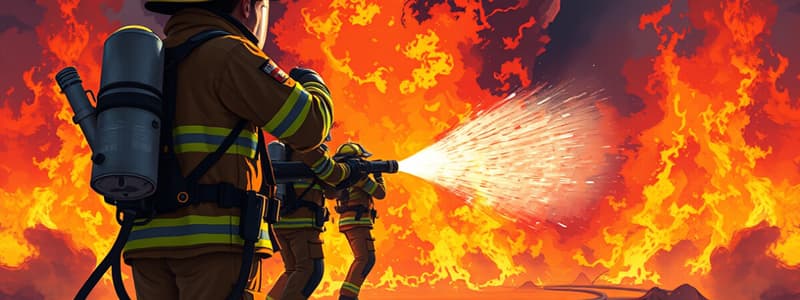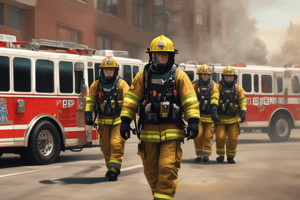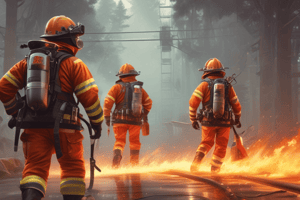Podcast
Questions and Answers
What is the primary purpose of conducting training drills for firefighters?
What is the primary purpose of conducting training drills for firefighters?
- To minimize physical exertion during real incidents
- To focus solely on theoretical classroom lessons
- To enhance competition among firefighters
- To create opportunities for practice incidents in a safe environment (correct)
Which of the following statements accurately reflects the mindset needed during training drills?
Which of the following statements accurately reflects the mindset needed during training drills?
- Drills should minimize risks as there are no lives to save (correct)
- Every drill should simulate high-risk emergencies almost exactly
- Performance expectations should always be prioritized over safety
- Training programs should not allow participants to intervene during unsafe acts
What is a key overhead commitment during training that reflects safety-minded values?
What is a key overhead commitment during training that reflects safety-minded values?
- The safety of participants takes precedence over performance expectations (correct)
- Participants should always follow their instincts without guidelines
- Performance metrics are the main focus during training
- Training should occur without preplanned protective measures
Which scenario requires the assignment of a dedicated Safety Officer (SO) based on NFPA standards?
Which scenario requires the assignment of a dedicated Safety Officer (SO) based on NFPA standards?
What type of training evolution can benefit specifically from having a separate safety officer?
What type of training evolution can benefit specifically from having a separate safety officer?
The history of firefighter line-of-duty deaths (LODDs) during training activities serves to highlight what issue?
The history of firefighter line-of-duty deaths (LODDs) during training activities serves to highlight what issue?
Why is it essential for participants to be empowered to stop unsafe acts during training?
Why is it essential for participants to be empowered to stop unsafe acts during training?
Which of the following guidelines should NOT be a focus during the planning of training drills?
Which of the following guidelines should NOT be a focus during the planning of training drills?
What is NOT a requirement for the SO prior to a training event?
What is NOT a requirement for the SO prior to a training event?
Which process is part of the three-step training approach for new ISOs?
Which process is part of the three-step training approach for new ISOs?
Which of the following does NOT typically occur during multiagency drills?
Which of the following does NOT typically occur during multiagency drills?
What is one responsibility of the SO during live-fire training events?
What is one responsibility of the SO during live-fire training events?
What is a critical component of NFPA 1403 regarding live-fire training?
What is a critical component of NFPA 1403 regarding live-fire training?
What should the IIC maintain in terms of instructor-to-student ratio?
What should the IIC maintain in terms of instructor-to-student ratio?
What responsibility does the SO NOT have during multiagency drill planning?
What responsibility does the SO NOT have during multiagency drill planning?
Which team composition is critical for live-fire safety?
Which team composition is critical for live-fire safety?
What precaution should SOs take to mitigate instructor health issues during training events?
What precaution should SOs take to mitigate instructor health issues during training events?
What does the 'C' in the MEDIC mnemonic stand for regarding the functions of a Safety Officer?
What does the 'C' in the MEDIC mnemonic stand for regarding the functions of a Safety Officer?
Which of the following is NOT a responsibility of the Safety Officer during pretraining planning?
Which of the following is NOT a responsibility of the Safety Officer during pretraining planning?
What is the primary purpose of using marking tape in a drill environment?
What is the primary purpose of using marking tape in a drill environment?
What is included in the predrill safety briefing prepared by the Safety Officer?
What is included in the predrill safety briefing prepared by the Safety Officer?
During a drill, which scenario would likely necessitate terminating the exercise?
During a drill, which scenario would likely necessitate terminating the exercise?
What is a key factor in developing a safety plan before a training event?
What is a key factor in developing a safety plan before a training event?
What training method follows shadowing in the progression of training new Safety Officers?
What training method follows shadowing in the progression of training new Safety Officers?
Which of the following is a primary focus of a Safety Officer during drill-day issues?
Which of the following is a primary focus of a Safety Officer during drill-day issues?
Which item is NOT considered a requirement of the Safety Officer according to pretraining planning?
Which item is NOT considered a requirement of the Safety Officer according to pretraining planning?
In the context of a multiagency drill, which preparatory step is not typically required?
In the context of a multiagency drill, which preparatory step is not typically required?
What is meant by 'off-limits areas' in a training scenario?
What is meant by 'off-limits areas' in a training scenario?
What is the purpose of using the term 'no-notice' in drill scenarios?
What is the purpose of using the term 'no-notice' in drill scenarios?
What does the acronym RIC stand for in the context of a Safety Officer's requirements?
What does the acronym RIC stand for in the context of a Safety Officer's requirements?
What is one of the primary drawbacks associated with no-notice drills?
What is one of the primary drawbacks associated with no-notice drills?
Which is NOT a preestablished guideline for conducting no-notice drills?
Which is NOT a preestablished guideline for conducting no-notice drills?
In the context of live-fire training, who bears the liability for injuries or loss during an incident?
In the context of live-fire training, who bears the liability for injuries or loss during an incident?
What is the recommended instructor-to-student ratio for live-fire training?
What is the recommended instructor-to-student ratio for live-fire training?
Which of the following is a core safety-minded value during training events?
Which of the following is a core safety-minded value during training events?
What role does the ignition officer play during live-fire training?
What role does the ignition officer play during live-fire training?
Which of the following tasks requires the immediate attention of the Safety Officer (SO)?
Which of the following tasks requires the immediate attention of the Safety Officer (SO)?
Why is it critical to follow NFPA 1403 guidelines?
Why is it critical to follow NFPA 1403 guidelines?
What is the purpose of establishing a safety team in live-fire training?
What is the purpose of establishing a safety team in live-fire training?
Which section in NFPA 1403 contains essential requirements for safety officers and instructors?
Which section in NFPA 1403 contains essential requirements for safety officers and instructors?
In the role of an Incident In Charge (IIC), what does planning and preparation include?
In the role of an Incident In Charge (IIC), what does planning and preparation include?
What should a safety officer do if they perceive an unsafe condition during training?
What should a safety officer do if they perceive an unsafe condition during training?
In what scenario should a no-notice approach be scrapped according to established guidelines?
In what scenario should a no-notice approach be scrapped according to established guidelines?
Flashcards are hidden until you start studying
Study Notes
Introduction to Training and Safety
- Training drills serve as "practice incidents," promoting a safety-oriented mindset for actual emergency responses.
- They provide an environment for firefighters and officers to enhance skills and identify weaknesses without risking lives.
- Emphasis is on experiential learning through in-context drills rather than traditional classroom training.
- The perception of safety during drills may be misleading as historical data indicate incidents of line-of-duty deaths linked to training.
Importance of a Safety Officer (SO) in Training Drills
- Firefighters should minimize risk during training drills, as there are no lives at stake.
- Core safety commitments include prioritizing participant safety, adhering to SOPs/SOGs, training within controlled environments, and empowering all personnel to halt unsafe actions.
- Specific training activities that require a dedicated safety officer include live-fire training, multi-agency drills, and high-risk training evolutions like water rescues.
Functions of the Safety Officer at Training Events
- The SO’s role mirrors that in actual incidents but involves specific adaptations for training contexts.
- Using the MEDIC mnemonic helps the SO remember their responsibilities: Monitor, Evaluate, Develop preventive measures, Intervene, Communicate.
- Pre-training planning and briefings are critical for ensuring safety and addressing potential hazards.
Pretraining Planning for Safety Officers
- SOs should establish clear communication and objectives with the instructor-in-charge (IIC) before a training event.
- Important planning considerations include training descriptions, minimum PPE requirements, rehabilitation protocols, and emergency procedures.
- Conducting a site survey is essential to assess hazards, permissions, and any potential liabilities.
Training New Safety Officers
- Training consists of three key steps: introductory classroom instruction, shadowing experienced officers, and practical coaching where the trainee performs SO duties under supervision.
Specific Functions at Multiagency Drills
- Preparation for multiagency drills involves initial training, tabletop exercises, functional drills, and written safety briefings.
- Safety briefings must outline expectations, PPE requirements, traffic management plans, and established hazards to ensure participant understanding.
- The SO must prioritize injury prevention over performance during drills and is responsible for post-drill checks and documentation of actions.
Handling No-Notice Drills
- No-notice drills evaluate spontaneous reactions but can create stress and confusion among firefighters.
- Guidelines for executing no-notice drills include ensuring prior training exposure, maintaining a safety plan, and having a designated SO in charge.
- When implemented correctly, no-notice drills can enhance evaluation processes without excessive pressure on responders.
Safety Officer Functions for Live-Fire Training
- NFPA 1403 outlines critical guidelines for live-fire training to mitigate risks.
- Compliance with NFPA standards is essential to avoid negligence claims in case of incidents.
- Responsibilities include building inspections, maintaining an effective instructor-to-student ratio, ensuring safety personnel, and implementing rehabilitation strategies for firefighters.
Conclusion
- Training exercises are essential for firefighter development, emphasizing safety values over performance, structured planning, and the integration of a dedicated safety officer.
- Understanding and adherence to safety regulations like NFPA 1403 plays a crucial role in the successful execution of firefighter training, ensuring both learning and safety for all participants.
Studying That Suits You
Use AI to generate personalized quizzes and flashcards to suit your learning preferences.




